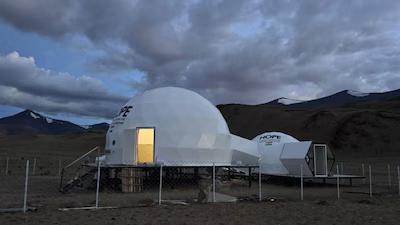
ISRO Sets Up Station in Ladakh to Simulate Life on Moon & Mars
The Indian Space Research Organisation (ISRO) has made a significant breakthrough in its quest to explore the vastness of space. In a bid to simulate life on the Moon and Mars, ISRO has set up the Himalayan Outpost for Planetary Exploration (HOPE) in Ladakh’s Tso Kar Valley. This unique facility will test life-support systems for future lunar and Martian missions, making it a significant step towards humanity’s quest for space exploration.
Located in the Tso Kar Valley, the HOPE station is situated at an altitude of 14,500 feet above sea level. The valley was chosen for its extreme environment, which is eerily similar to the Martian terrain. The site experiences high UV radiation, low atmospheric pressure, extreme cold, and saline permafrost, making it an ideal location to simulate the harsh conditions of the Red Planet.
From August 1 to 10, two crew members will undertake various tests at the facility to assess the feasibility of human life on Mars. The crew members will conduct experiments to evaluate the performance of life-support systems, including air, water, and food supplies. The tests will also focus on the psychological and physical well-being of the crew, simulating the long-duration space missions.
The HOPE station is equipped with state-of-the-art facilities, including life-support systems, communication equipment, and scientific instruments. The team will also have access to a synthetic Martian terrain, designed to mimic the Martian surface. The station’s remote location and harsh environment will provide a unique opportunity for scientists to test the limits of human survival.
ISRO’s HOPE mission is a significant step towards its ambitious plan to send humans to Mars by 2050. The organization has been working tirelessly to develop the necessary technologies and infrastructure to support long-duration space missions. The HOPE station will play a crucial role in this endeavor, providing valuable insights into the challenges and opportunities that come with exploring the Red Planet.
The Tso Kar Valley, located in the Ladakh region of Jammu and Kashmir, is a picturesque destination known for its breathtaking natural beauty. The valley is home to several lakes, including the Tso Kar Lake, which is the largest lake in the region. The area is also rich in biodiversity, with several rare and endangered species of flora and fauna.
The HOPE station is a testament to ISRO’s commitment to advancing space exploration and expanding our understanding of the universe. The organization has made significant strides in recent years, including the successful launch of the Chandrayaan-1 mission, which discovered water on the Moon. The HOPE mission is a natural extension of this success, and it is expected to provide valuable insights into the challenges and opportunities that come with exploring the Moon and Mars.
In conclusion, ISRO’s HOPE mission is a significant step towards humanity’s quest for space exploration. The Himalayan Outpost for Planetary Exploration in Ladakh’s Tso Kar Valley is a unique facility that will test life-support systems for future lunar and Martian missions. The mission is a testament to ISRO’s commitment to advancing space exploration and expanding our understanding of the universe.






